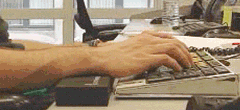Paul Manley Back Pain and RSI Clinic
Paul Manley, M.A.O.(Manip), Registered OsteomyologistFor muscle and joint problems

RSM (Royal Society of Medicine)
Specialist in the treatment of Musculo-skeletal problems
Location: 8-10 Boston Place, Marylebone, London NW1 6QH
Next to Marylebone Station, Main line trains and Bakerloo line
19/01/2026
RSI trigger areas: musculo-skeletal
What is RSI?>> RSI muscle triggers>> RSI nerve triggers>> RSI pathophysiology>> RSI treatment
Why do some people get RSI from a particular activity whilst others performing the same activity are seemingly immune?From my observations it would appear that the main factors in giving an increased likelihood for RSI fall into the following categories:
- Musculo-skeletal.
- Neural encroachment and compression.
- Degree of time spent performing activities.
- Intensity of actions required
Musculo-skeletal factors consist of the shortening and tightening of any or all of the following trigger areas:
- Lower Cervical deep spinal muscles and Osteopathic lesions in this area
- Upper ribcage lesions, most commonly where ribs 1 to 3 are stuck in an elevated position. This commonly exists along with deep tension in the upper fibres of Trapezius, the intercostal muscles and spinal muscles overlying the upper dorsal spine
- Tension patterns in the rotator cuff muscles, principally Teres major and minor, Infraspinatus, Subscapularis, Supraspinatus and Pectoralis Minor
- The deep fibres of Biceps with occasional involvement of Brachialis
- The superficial and deep flexors of the wrist and fingers and thumb which lie on the palm side of the forearm
- The deep fibres of Brachioradialis
- The deep extensors of the wrist and fingers which lie on the back of the forearm
- The deep and superficial palm and finger flexors in the hand
All of these areas must be examined thoroughly for any hypertonus (tension) and deficient ranges of movement where the joints are involved.
The trained hand will know precisely where these areas are and then with the right skills, 'undo' them. The skills needed are primarily the educated sense of touch, like a potter or pianist, and then the techniques to do something about what you find.
The most commonly involved trigger areas are in the deep extensors and flexors of the wrist and fingers as well as the muscles of the Thenar eminence (thumb). This is most evident in cases where the use of a mouse and typing have over-tightened the deep extensor tendons, the deep flexor tendons and the thumb muscles. These, in order of appearance constitute the basic building block of RSI of the forearm and hands.
When you add in the all too common shoulder and neck tension patterns, you will become very likely to suffer from RSI.

What is RSI?>> RSI muscle triggers>> RSI nerve triggers>> RSI pathophysiology>> RSI treatment
07925 616 753
Location: 8-10 Boston Place, Marylebone, London NW1 6QH
Next to Marylebone Station, Main line trains and Bakerloo line